|
|
|
Sort Order |
|
|
|
Items / Page
|
|
|
|
|
|
|
| Srl | Item |
| 1 |
ID:
178418
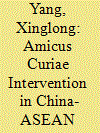

|
|
|
|
|
| Summary/Abstract |
One main criticism levelled against the investor-state dispute settlement system (ISDS) is the existence of limited opportunities for amicus intervention. Against this backdrop, this article firstly studies what reforms regarding amicus intervention in ISDS proceedings have been put forward by China and ASEAN countries and the relevant dilemmas. Subsequently, to ensure that maximum benefits can be realised from amicus participation in ISDS proceedings in China-ASEAN Free Trade Area (CAFTA), this article proposes procedures for when and how an amicus may participate in arbitral proceedings under the upcoming investment agreements, particularly the Regional Comprehensive Economic Partnership (RCEP). Additionally, given the fact that the level of amicus participation in ISDS proceedings is still limited, the article suggests that China and ASEAN need to establish safeguards to provide amici with access to key arbitral documents and oral hearings. However, achieving the above objectives should not come at the expense of undermining the confidential and protected information of both disputing parties.
|
|
|
|
|
|
|
|
|
|
|
|
|
|
|
|
| 2 |
ID:
178417
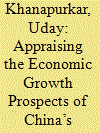

|
|
|
|
|
| Summary/Abstract |
This article examines the economic growth prospects of China’s services sector. Reportage on China’s economy and its data releases tends to focus largely on aggregate GDP growth, manufacturing growth, retail sales and investments, and fails to adequately cover services despite them being the largest contributor to growth. The article parses the growth of China’s various services subcomponents across a range of parameters and assesses that the industry has come under duress with a slowdown in complementary manufacturing and the dissipation of growth bubbles in finance and real estate. It is further observed that reforms necessary for spurring services growth are at a nascent stage, proceed slowly, and are imperilled by GDP growth targets that result in policies favouring the manufacturing industry. In sum, while China’s services growth prospects are hardly in dire jeopardy due to favourable demand-side conditions, achieving potential and affecting convergence with high income countries will necessitate the expedition of reforms and the engineering of a sustained high growth phase in the sector.
|
|
|
|
|
|
|
|
|
|
|
|
|
|
|
|
| 3 |
ID:
178422
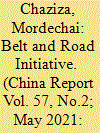

|
|
|
|
|
| Summary/Abstract |
The Republic of Yemen (North Yemen) and the People’s Republic of China (PRC) established diplomatic relations in 1956, the first Arabian Peninsula country to recognise the PRC as the legitimate representative of the country. Yemen is a significant and strategically important state in the southern Arabian Peninsula bordering Saudi Arabia, Oman, the Red Sea, and the Gulf of Aden within the Arabian Sea (Behbehani. 1985. China and the People’s Democratic Republic of Yemen). The geographical location of Yemen makes it an essential state for the PRC because it enables it an observation point over three regional trouble spots: the Gulf of Aden, the Red Sea, and the Horn of Africa. Thus, Yemen can become the bridge between Asia and Africa, and between the Indian Ocean and the Mediterranean, and a vital component of China’s Silk Road Strategy. The Belt and Road Initiative (BRI) could be used as a new driving force for the Sino-Yemen relationship, especially the integration between the state’s post-war reconstruction and the realization of the initiative.
|
|
|
|
|
|
|
|
|
|
|
|
|
|
|
|
| 4 |
ID:
178419
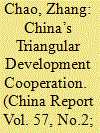

|
|
|
|
|
| Summary/Abstract |
Triangular development cooperation (TDC) is an increasingly popular modality in the aid field. It is seen to have both huge potential and limits. As the largest emerging donor, China’s participation in TDC has been put under the spotlight. This article proposes a working definition of TDC focused on the type of resources transferred, and establishes a data set on the projects that China was involved in, from 2005 to 2016. Moreover, it investigates China’s perception of the TDC by analysing its official publications. It finds that (a) China holds an equivocal understanding of the TDC concept; (b) although China has been rhetorically stressing the importance of TDC, few real actions have been taken; (c) China prefers international organisations in TDC instead of traditional donors; and (d) like other actors, most of China’s TDC projects are recorded in non-economic sectors. At the moment, China remains cautious regarding the modality. But considering the growing volume of Chinese aid and its visibility, a more proactive stance on TDC might better serve Chinese interests.
|
|
|
|
|
|
|
|
|
|
|
|
|
|
|
|
| 5 |
ID:
178420


|
|
|
|
|
| Summary/Abstract |
The climate change issue evolved as a significant policy priority within the China’s political establishment. The major factor that determines Beijing’s climate policy is the prevailing and potential climate change impact on the country’s economic development. As economic development is the foremost, pre-existing and abiding political concern, political leaders construct the climate change impact as a major threat to the country’s economic prosperity. Thus, political leaders’ overriding priority is to protect economic development—a referent object—from the perils of climate change. However, the interplay of climate threat and economic development drives political leaders to embrace security institution and develop military mind set to contend with climate-led development policies that trigger the securitisation of the development process in China. Employing the discourse analysis method, this paper examines the securitisation of development debate in China, especially at the domestic level, from the standpoint of the securitisation theory.
|
|
|
|
|
|
|
|
|
|
|
|
|
|
|
|
| 6 |
ID:
178421
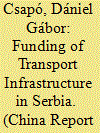

|
|
|
|
|
| Summary/Abstract |
In the Western Balkans, Serbia is considered one of China’s key partners, represented both in the political sphere and financially in the number of investments from Chinese corporations and banks. This paper examines the rate of Chinese expansion in Serbia by examining the investments in Serbian transportation infrastructure. It also analyses the relationship between the two countries and examines the response of other powers towards the Chinese expansion in Serbia. The annual report of the Ministry of Construction, Transport and Infrastructure (MGSI), Serbia summarises the recently implemented, ongoing and planned investments. According to this document, from 2004 to 2020 Serbia has and is planning to invest nearly EUR 6 billion into development projects with a 3:1 ratio in favour of investments to railway projects (MGSI 2018, ‘Overview of Finalised, Ongoing and Planned Transportation and Construction Infrastructural Projects,. 3). Although European institutions play a crucial role in financing the projects, Chinese financial institutions are becoming increasingly influential. Based on the assessment of the data in the Ministry report and considering the projects with an identified financing provider, one-fifth of the total value is provided by the Chinese banks. While the Chinese side argues that they strive to ensure a ‘win-win’ position for all stakeholders, the European Union (notably, the Western Member States) and the United States have reservations about Chinese expansion in the region.
|
|
|
|
|
|
|
|
|
|
|
|
|
|
|
|
|
|
|
|
|